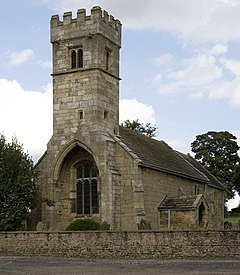Cowthorpe
| Cowthorpe | |
|---|---|
 St Michael's Church, Cowthorpe | |
Location within North Yorkshire | |
| OS grid reference | SE427524 |
| District | |
| Shire county | |
| Region | |
| Country | England |
| Sovereign state | United Kingdom |
| Post town | WETHERBY |
| Postcode district | LS22 |
| Police | North Yorkshire |
| Fire | North Yorkshire |
| Ambulance | Yorkshire |
Cowthorpe is a village in the Harrogate district of North Yorkshire, England. It is situated 3 miles (4.8 km) north of Wetherby, 10 miles (16 km) east of Harrogate, 7 miles (11 km) from Knaresborough and 13.5 miles (21.7 km) from York.[1]
History
The name of Cowthorpe comes from Old Norse and is a combination of a personal name Koli and þorp (which means settlement or outlying hamlet).[2]
The village lies on a minor road that connects it with North Deighton (and the A168) to the west and Tockwith in the east. It is bordered by the River Nidd to the north with bridges crossing the Nidd at either Walshford in the west, or Cattal Bridge in the east.[3]
St Michael's Church
St Michael's Church in the village is a Grade I listed building, built by a Brian Roucliffe, and consecrated in 1458.[4] In the choir, on a large flat stone, are the effigies, in brass, of a man and his wife, bearing betwixt them the model of a church, and supposed, from the inscription, likewise in brass, now scarce legible, to be in memory of the Founder and his wife.[5]
The Cowthorpe Oak

Cowthorpe is the home of an enormous tree, the Cowthorpe Oak. Its circumference is 60 feet (18 m); its principal limb (which is propped) extends 48 feet (15 m) from the bole. The tree is decaying fast; tradition speaks of its being in decay for many generations. "Compared with this," says Dr. Hunter, in Evelyn's Silva, "all other trees are children of the Forest." According to an early history of Knaresborough, "The leading branch fell, by a storm, in the year 1718; which, being measured with accuracy, was found to contain five tons and two feet of wood. Before this accidental mutilation, its branches are said to have extended their shade over half an acre of ground; thus constituting, in a single tree, almost a wood itself".[6]
Langdale's Topographical Dictionary of Yorkshire (1822) records that "This venerable oak is decaying fast, the trunk and several of the branches appearing to be completely rotten, except the bark; tradition speaks of its being in decay for many generations. The intermixture of foliage amongst the dead branches, show how sternly this giant struggles for life, and how reluctantly it surrenders to all conquering time".[7]
The tree, which was painted by J.M.W. Turner, finally died in 1950.[8]
References
- ^ Palliser, Pickersgill (1840). Palliser's history and directory of Harrogate. Harrogate: P Palliser. p. 78. OCLC 234717753.
- ^ Ekwall, Eilert (1960). The concise Oxford dictionary of English place-names (4 ed.). Oxford: Clarendon Press. p. 127. ISBN 0-19-869103-3.
- ^ "289" (Map). Leeds. 1:25,000. Explorer. Ordnance Survey. 2015. ISBN 9780319244869.
- ^ Historic England. "Church of St Michael (Grade I) (1315417)". National Heritage List for England. Retrieved 27 November 2017.
- ^ Cowthorpe
- ^ The Cowthorpe Oak
- ^ Langdale, Thomas (1822). A topographical dictionary of Yorkshire : a brief history of places most remarkable for antiquities, biographical eminent persons. Northallerton: J Langdale. p. 263. OCLC 866346904.
- ^ Rafcliffe, Roger (28 September 2016). "Country & Coast: A Yorkshire tree as old as Magna Carta". The Yorkshire Post. Retrieved 27 November 2017.
External links
- Historic England. "Details from listed building database ({{{num}}})". National Heritage List for England.

